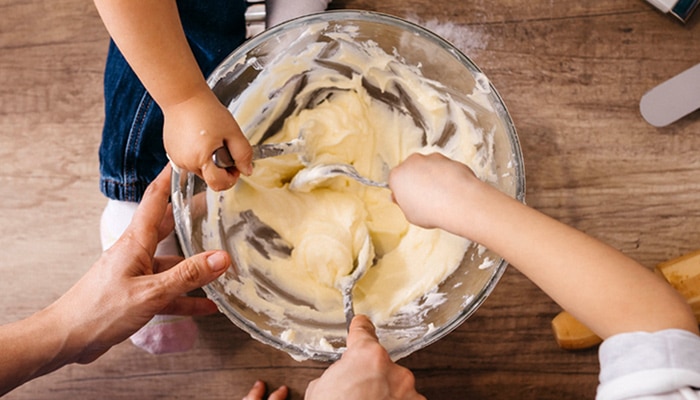While we believe that the books and resources recommended may be of value to you, keep in mind that these are suggestions only and you must do your own due diligence to determine whether the materials are appropriate and suitable for your use. PNC has no sponsorship or endorsement agreement with the authors or publishers of the materials listed.
FARM TO PRESCHOOL

Let's Make Butter
Children will experiment with liquids and solids by making butter.

Lesson Objective
Children will investigate characteristics of liquids and solids, and experiment with changing states—turning a liquid into a solid.
Science
What You'll Need
- Cups of various liquid foods such as water, milk, juice
- Plates with examples of solid foods such as crackers, bread
- Clean, empty plastic jars with lids – 1 per child
- Heavy cream – ¼ cup per child
- Salt – 1 dash per jar
- Measuring cups – 1 per 4 children
- Plastic spoons – 1 per child
- Paper plates – 1 per child
- Crackers
What To Do
- Display the liquids, and discuss the characteristics of a liquid (see Did You Know?).
- Display the solids, and discuss the characteristics of solids (see Did You Know?).
- Compare the liquids and the solids (see Guiding Student Inquiry).
- Tell the children that they will be making butter, which is a product that begins as a liquid but can be turned into a solid.
- Distribute the jars. Help the children to measure ¼ cup of heavy cream and pour it into their jar.
- Add a dash of salt, and firmly seal the lids.
- Tell the children that they will need to shake the jars until the cream becomes solid.
- Once the butter forms, help the children drain off the liquid, and ask what happened to the liquid (see Guiding Student Inquiry).
- Use the butter immediately by allowing the children to use the knives to spread it on crackers and enjoy it as a snack.
Resources
Home School Resources
Home educators: use these printable lesson PDFs to teach this lesson to your home schoolers. They're available in English and Spanish.
Content Provided By
Common Core State Standards Initiative – These lessons are aligned with the Common Core State Standards ("CCSS"). The CCSS provide a consistent, clear understanding of the concepts and skills children are expected to learn and guide teachers to provide their students with opportunities to gain these important skills and foundational knowledge [1]. Visit the CCSS


